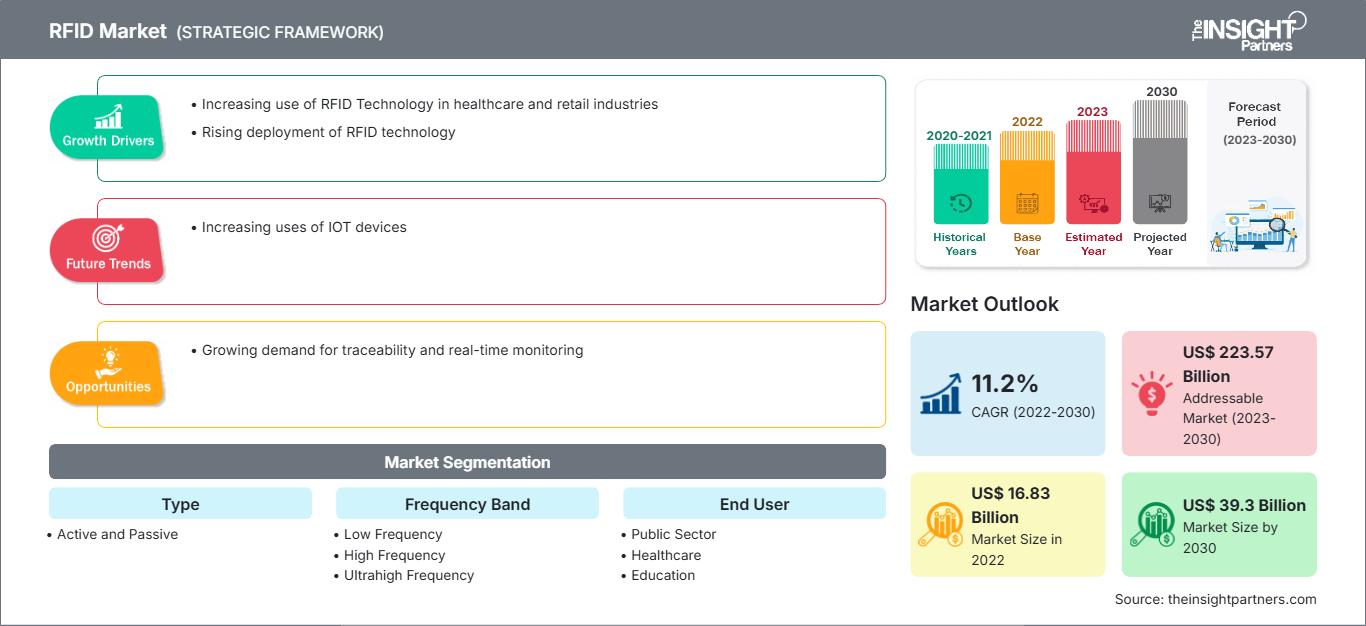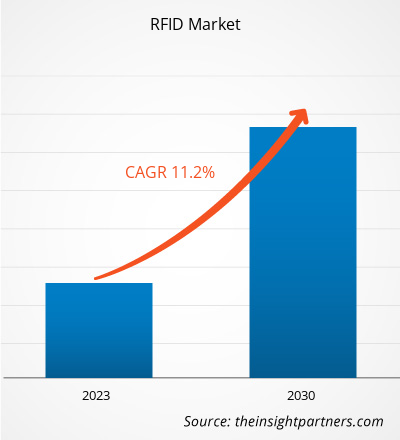[研究报告] RFID 市场规模预计将从 2022 年的 168.3 亿美元增长到 2030 年的 393 亿美元;预计 2023 年至 2030 年的复合年增长率为 11.2%。
分析师观点:
随着技术的进步和人们对其优势的认识不断提高,RFID 市场技术的应用范围不断扩大,涵盖食品、航空和区块链等多个行业。例如,RFID 标签可以贴在食品上,以追踪其在整个供应链中的流动情况。它有助于改善库存管理,防止食品变质,并确保食品安全。2022 年 4 月,国际连锁餐厅 Chipotle Mexican Grill 使用 RFID 市场技术来增强其芝加哥配送中心的可追溯性和库存系统。2023 年,Chipotle Mexican Grill 扩大了 RFID 市场技术的使用范围,以实时追踪供应商的食材。 RFID 市场技术使 Chipotle Mexican Grill 能够实时查看其配送中心和餐厅的库存。此外,这家连锁餐厅的供应商也使用 RFID 市场技术来改进库存管理流程。
此外,斯道拉恩索于 2021 年 4 月推出了其“全球首款”可回收 RFID 标签,可用于微波炉加热。Eco Meal RFID 标签专为单品级即食餐食的标记和追踪而设计。此类应用和产品开发推动了 RFID 市场参与者在食品行业产品和服务的普及。
市场概览:
RFID 可以追踪从工厂到零售店的整个制造和供应链中物料和产品的流动情况。它有助于提高效率、避免错误、降低成本、追踪库存水平并防止盗窃。
库存管理需求的不断增长推动了零售店对 RFID 市场技术的采用。2023 年 6 月,服装品牌 Pacific Sunwear of California Inc.(PacSun)在其三家门店部署了 RFID,以提高库存准确性。据PacSun称,RFID技术帮助他们将库存管理的准确率从70%提升至98%。此外,2023年3月,American Eagle Outfitters Inc.、Victoria's Secret & Co.和Nordstrom Inc.宣布,他们将扩大新一代RFID芯片的使用范围,以增强供应链信息。RFID将有助于缩小顾客在商店试穿和移动商品时产生的误差。纽约约500家American Eagle门店将配备RFID市场份额技术。此类部署将有助于提升RFID市场参与者的收入。
自定义此报告以满足您的要求
您将免费获得任何报告的定制,包括本报告的部分内容,或国家级分析、Excel 数据包,以及为初创企业和大学提供超值优惠和折扣
RFID市场: 战略洞察

-
获取本报告的主要市场趋势。这个免费样本将包括数据分析,从市场趋势到估计和预测。
市场驱动因素:
RFID 技术在医疗保健和零售行业的应用日益广泛
RFID 标签可以贴在患者的腕带或物品上,以追踪他们的位置和状态。它有助于防止患者被绑架并改善患者护理。RFID 标签可以贴在药瓶上,以追踪药瓶库存,确保患者获得正确的药物。它可以防止用药错误,避免用药错误对患者造成伤害。2021 年 8 月,Terso Solutions, Inc. 在美国近 1,000 家医疗机构部署了其 RAIN 射频识别 (RAIN RFID) 解决方案。该解决方案提供实时可见性,并可通过 Terso Solutions, Inc. 的云软件集成到现有的 EHR/ERP 系统中。此外,2022 年 2 月,Impinj, Inc. 表示已加入 DoseID 联盟,以加大对 RAIN 射频识别 (RAIN RFID) 在医疗保健行业的应用的重视。此外,为了参与制定 RAIN RFID 标准,Impinj, Inc. 与医疗保健提供商合作,利用其 RAIN RFID 市场技术,通过自动化系统保护患者和员工,并更好地管理资产和库存,打造增强患者护理、节省成本和提高效率的解决方案。RFID 技术部署的优势推动了医疗保健行业对 RFID 市场的增长。
RFID 可用于实时跟踪库存,从而帮助零售商提高库存准确性并减少缺货。RFID 还可以通过阻止商店扒手并确保只有授权人员才能接触库存来防止盗窃和欺诈。2023 年 5 月,SML 集团与 PervasID 合作,通过 PervasID 的 RFID 读取器技术与 SML 的 Clarity 企业软件解决方案的独特组合,为零售商店和品牌提供实时产品可视性和定期库存水平信息。此类合作有助于推动零售行业采用 RFID 市场份额技术。
细分分析:
根据频段,RFID 市场份额分为低频、高频和超高频。高频部分在 2022 年占据了最大的市场份额,而超高频部分预计在预测期内将实现最高的复合年增长率。超高频 RFID 标签可以粘贴到金属产品和材料上,实现实时可视性和自动化库存管理。它有助于减少人为错误、改善库存、提高准确性并增强供应链效率。2022 年 2 月,Identiv, Inc. 推出了其 UHF(超高频)RFID TOM(金属标签)产品。UHF RFID TOM 专为在金属和几乎所有其他类型的表面使用而开发,提供约 4.5 米的长读取范围(在非金属表面的读取范围更长)。 UHF RFID TOM 具有很强的抗环境干扰能力,在金属上可提供高达 10 米的出色读取范围,并且可以安装在凸面或凹面金属表面上。
区域分析:
全球 RFID 市场参与者大致分为五大区域——北美、欧洲、亚太地区 (APAC)、中东和非洲 (MEA) 以及南美和中美 (SAM)。
北美是各种 RFID 市场参与者的所在地,它们生产 RFID 产品和服务,包括 SML 集团、Impinj, Inc 和 HID Global Corporation(ASSA ABLOY 的一部分)。这些市场参与者不断致力于扩展其产品并为客户提供创新解决方案。2022 年 5 月,HID Global Corporation 收购了 Vizinex,以扩展其高性能无源 RFID 标签产品组合。此次收购增强了 HID Global Corporation 的资产跟踪标签产品组合。市场参与者不断增加的投资推动了北美RFID市场参与者的增长,并有助于RFID市场的增长。
在欧洲,多家公司正在扩大其地域影响力。例如,2023年2月,Identiv公司在欧洲开设了一家新的制造工厂。该工厂凭借价格极具竞争力的专业超高频(UHF)产品组合,扩大了Identiv公司在全球各大洲的影响力。该公司已与Trace Trace-ID达成战略协议,将为欧洲制造商提供一流的专业和工业超高频RFID产品。欧洲国内和全球市场参与者的扩张正在推动该地区RFID市场的增长。
亚太各国政府正在将RFID技术应用于军事领域。2022年2月,印度军方宣布已实施RFID标签用于弹药追踪。RFID的实施提高了弹药库所有技术活动的效率,并降低了库存持有成本。亚太地区的公司也在利用RFID市场增长技术来减少碳足迹。 2022年10月,普利司通公司使用RFID标签生产带有RFID标签的轮胎,从而改善了其商用车轮胎系列的回收利用。带有标签的轮胎将连接到云端系统,以帮助监控轮胎的性能和状况。因此,制造业的技术进步正在推动亚太地区RFID市场的增长。
关键参与者分析:
RFID市场分析包括斑马技术公司 (Zebra Technologies Corp.)、亚萨合莱 (Assa Abloy AB)、霍尼韦尔国际公司 (Honeywell International Inc)、欧姆龙公司 (OMRON Corp)、西门子股份公司 (Siemens AG)、MIWA Lock Co、Impinj Inc.、dormakaba Holding AG、Bar Code India Ltd 和 APK Identification 等参与者,它们都是全球RFID市场的主要参与者。
RFID 市场区域洞察
The Insight Partners 的分析师已详尽阐述了预测期内影响 RFID 市场的区域趋势和因素。本节还讨论了北美、欧洲、亚太地区、中东和非洲以及南美和中美洲的 RFID 市场细分和地理分布。
RFID市场报告范围
| 报告属性 | 细节 |
|---|---|
| 市场规模 2022 | US$ 16.83 Billion |
| 市场规模 2030 | US$ 39.3 Billion |
| 全球复合年增长率 (2022 - 2030) | 11.2% |
| 历史数据 | 2020-2021 |
| 预测期 | 2023-2030 |
| 涵盖的领域 |
By 类型
|
| 覆盖地区和国家 |
北美
|
| 市场领导者和主要公司简介 |
|
RFID 市场参与者密度:了解其对业务动态的影响
RFID 市场正在快速增长,这得益于终端用户需求的不断增长,而这些需求的驱动因素包括消费者偏好的不断变化、技术进步以及对产品优势的认知度不断提高。随着需求的增长,企业正在扩展其产品线,不断创新以满足消费者需求,并抓住新兴趋势,从而进一步推动市场增长。

- 获取 RFID市场 主要参与者概述
最新动态:
RFID 市场中的企业广泛采用并购等非自主和自主战略。以下列出了一些 RFID 市场参与者的最新关键动态:
- 2022 年,艾利丹尼森在巴西的新智能标签工厂投入运营。新工厂旨在满足国内市场以及南美其他地区各行业日益增长的需求,这些需求受到全新“非接触式”消费者体验和全渠道模式的推动。
- 2022 年,SML 和 PervasID 将提供创新的高精度超高频 (UHF) 射频识别 (RFID) 读取器系统,用于自动化库存和资产跟踪。此次独家合作将专注于提供 PervasID 的无源 RFID 阅读器技术与 SML 的 Clarity 企业软件解决方案的独特组合,从而为零售商带来更高的利润。
- 2022 年,TagMaster 推出了用于停车和门禁控制的新型 RFID 阅读器 — XT-5。 XT-5 是一款 RFID 读取器,专为门禁控制区域和停车应用(例如机场停车场、铁路站场和公交车场、自动卡车活动和内部物流)的解决方案而设计和优化。
- 2022 年,巴西邮政在装有数百个包裹的货物集装箱上安装了 RFID 标签,并在运营单位的出入口安装了约 2,000 个读取器,以便通过其网络更好地跟踪信件和包裹。
- 2022 年,艾利丹尼森公司宣布推出新型 AD Twist U7XM 嵌体,适用于汽车、航空航天和其他工业领域等具有挑战性的环境中库存和供应链管理应用。全新超高频 (UHF) RFID 嵌体专为存在金属的环境而设计,例如管道、管材和线束内。
- 2021 年,全新 AD Slim DF EM4425 标签专为物流、医疗和工业用例而设计,并提供客户互动功能。它为库存管理和产品认证提供强大的一体化解决方案,从而在各个渠道提供一致的客户体验。
- 2021 年,HID Global 宣布收购巴西 RFID 硬件制造商和经销商 ACURA。此次收购增强了 HID Global 的 RFID 产品组合,同时提升了公司在拉丁美洲的影响力和市场竞争力。
- 2021 年,SML RFID 推出高性能 GB3U9 嵌体。 GB3U9 搭载恩智浦最新的 RFID 芯片 UCode9,具有出色的读取灵敏度,可在密集的 RFID 标签群中实现高质量、快速的库存盘点。GB3 芯片为零售服装、鞋类、化妆品和电子行业提供了独特的选择。
- 2021 年,SML 集团推出了 GB24U,这是一种双标签技术,将 RFID 的单品级追踪功能与电子商品防盗系统 (EAS) 标签的防损功能相结合。
- 历史分析(2 年)、基准年、预测(7 年)及复合年增长率
- PEST和SWOT分析
- 市场规模、价值/数量 - 全球、区域、国家
- 行业和竞争格局
- Excel 数据集
近期报告
客户评价
购买理由
- 明智的决策
- 了解市场动态
- 竞争分析
- 客户洞察
- 市场预测
- 风险规避
- 战略规划
- 投资论证
- 识别新兴市场
- 优化营销策略
- 提升运营效率
- 顺应监管趋势






















 获取免费样品 - RFID市场
获取免费样品 - RFID市场